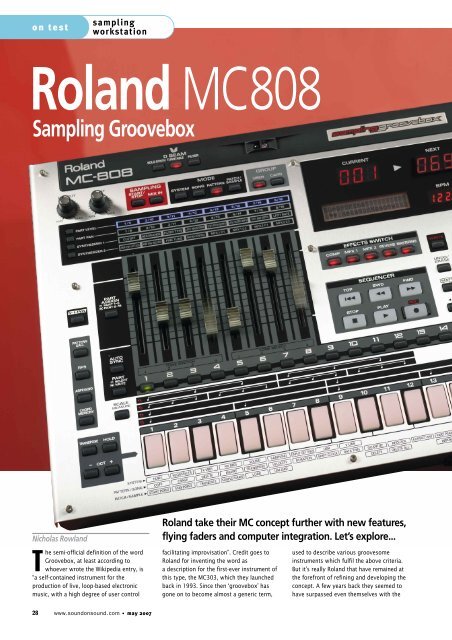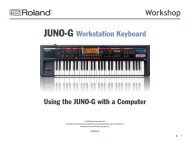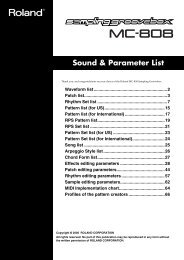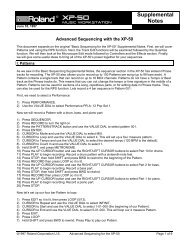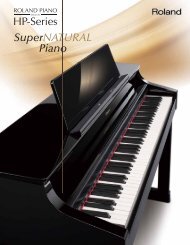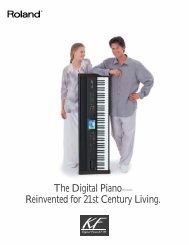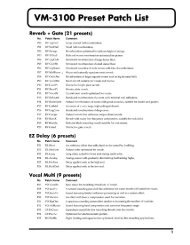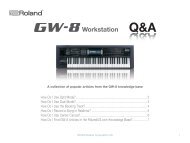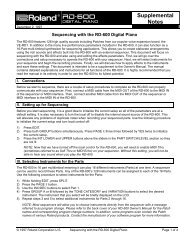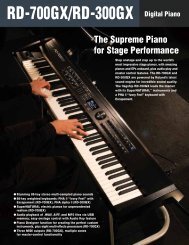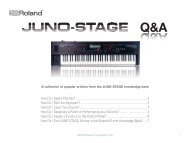SOS review the MC-808.pdf - Roland UK
SOS review the MC-808.pdf - Roland UK
SOS review the MC-808.pdf - Roland UK
Create successful ePaper yourself
Turn your PDF publications into a flip-book with our unique Google optimized e-Paper software.
on testsamplingworkstation<strong>Roland</strong> <strong>MC</strong>808Sampling GrooveboxNicholas Rowland<strong>Roland</strong> take <strong>the</strong>ir <strong>MC</strong> concept fur<strong>the</strong>r with new features,flying faders and computer integration. Let’s explore...The semi-official definition of <strong>the</strong> wordGroovebox, at least according towhoever wrote <strong>the</strong> Wikipedia entry, is“a self-contained instrument for <strong>the</strong>production of live, loop-based electronicmusic, with a high degree of user controlfacilitating improvisation”. Credit goes to<strong>Roland</strong> for inventing <strong>the</strong> word asa description for <strong>the</strong> first-ever instrument ofthis type, <strong>the</strong> <strong>MC</strong>303, which <strong>the</strong>y launchedback in 1993. Since <strong>the</strong>n ‘groovebox’ hasgone on to become almost a generic term,used to describe various groovesomeinstruments which fulfil <strong>the</strong> above criteria.But it’s really <strong>Roland</strong> that have remained at<strong>the</strong> forefront of refining and developing <strong>the</strong>concept. A few years back <strong>the</strong>y seemed tohave surpassed even <strong>the</strong>mselves with <strong>the</strong>28www.soundonsound.com • may 2007
magnificently specified — and indeedmagnificently priced — <strong>MC</strong>909 (<strong>review</strong>ed inSound on Sound in March 2003) which for<strong>the</strong> first time added sampling to <strong>the</strong> potentGroovebox mix.One After 909Photos: Mark EwingThe <strong>MC</strong>808 is <strong>the</strong> latest model in <strong>the</strong>Groovebox dynasty and as both its price tagand <strong>the</strong> numerical component of its namemight indicate, it represents a scaling backof <strong>the</strong> <strong>MC</strong>909’s grand designs. But onlyslightly so, as it still offers a similararmoury of sampling, 16-part multitimbralsynth, 16-track sequencer, oodles of effectsand plenty of hands-on controls to, er, layyour hands on. In fact, <strong>the</strong> progress oftechnology, coupled with lower productioncosts, means that although it ships at muchless than half <strong>the</strong> price of its older bro<strong>the</strong>r,<strong>the</strong> new arrival still manages to trump it ina number of areas.Firstly, at 128 notes itssyn<strong>the</strong>sis/sampling engine offers double<strong>the</strong> amount of polyphony of <strong>the</strong> <strong>MC</strong>909.Secondly, it can take double <strong>the</strong> amount ofsample RAM: a maximum of 516MB if youcount <strong>the</strong> onboard memory. And thirdly,although it has fewer hardware knobs andswitches overall, <strong>the</strong> eight faders whichcomprise its principal real-time controls aremotorised. Not only is this good for <strong>the</strong>‘bling’ factor, it means that <strong>the</strong> positions of<strong>the</strong> faders always reflect <strong>the</strong> actual valuesof <strong>the</strong> parameters that <strong>the</strong>y happen to becontrolling at <strong>the</strong> time: essential whenyou’re manipulating an instrument like thisduring a live performance. And for <strong>the</strong>semore sophisticated performances, <strong>the</strong>re’salso <strong>the</strong> ability to hook <strong>the</strong> <strong>MC</strong>808 intoa V-Link system (<strong>Roland</strong>’s proprietary videocontrol format), to allow <strong>the</strong> manipulationof images via <strong>the</strong> <strong>MC</strong>808’s front panel.O<strong>the</strong>r features intended to augment <strong>the</strong> liveexperience include a D-Beam controller,<strong>Roland</strong>’s modern take on <strong>the</strong> Theremin,whereby <strong>the</strong> wave of a hand can be used tovariously control <strong>the</strong> pitch of a monosynthsound, <strong>the</strong> tempo of a pattern, or <strong>the</strong> valuesof synth parameters such as filter cutoffand resonance.Getting PhysicalHoused in a plastic chassis with analuminium front panel, <strong>the</strong> <strong>MC</strong>808 is lightenough to be easily transportable, butappears robust enough to survive more thana night or two on <strong>the</strong> tiles. The lion’s shareof <strong>the</strong> surface area is taken up with <strong>the</strong>motorised faders, with sequencer controlsto <strong>the</strong> right and <strong>the</strong> 16 buttons forindividually triggering and programmingbeats and sounds below. The faders<strong>the</strong>mselves, which, apart from a value dialand <strong>the</strong> rotary input and output volumeknobs, are <strong>the</strong> only significant twiddleablebits on <strong>the</strong> front panel, operate in variousmodes. For example, <strong>the</strong>y give you controlrespectively of <strong>the</strong> volume and pan of <strong>the</strong>different parts within a pattern or <strong>the</strong>y canbe switched to control <strong>the</strong> synth parametersof individual parts. And it’s as you switchbetween <strong>the</strong>se modes that you begin toappreciate <strong>the</strong> value of having <strong>the</strong> fadersautomatically jump to <strong>the</strong> correct position.What’s slightly scary is that <strong>the</strong>y seem torattle quite noisily while doing it, though ifyou’re worried about <strong>the</strong>ir long-termrobustness you can always switch <strong>the</strong>motors off.O<strong>the</strong>r aspects of <strong>the</strong> <strong>MC</strong>808’s designvery much reflect <strong>the</strong> fact that <strong>the</strong>Groovebox concept is all about liveperformance, often in less than idealconditions. For example, all buttons arebacklit and a brightly illuminated blue panelshows exactly which matrix of parameters<strong>the</strong> faders are controlling. Along with <strong>the</strong>LCD screen (which gives you <strong>the</strong> detailedinformation on patch names, parametersand functions), <strong>the</strong>re are three large LEDdisplays which separately show crucialperformance data such as tempo and <strong>the</strong>numbers of <strong>the</strong> current and next patterns.Round <strong>the</strong> back you’ll find <strong>the</strong> mainstereo outputs plus two extra direct outs.Audio input duties are handled by a coupleof quarter-inch jack sockets. These arenominally line level, though <strong>the</strong> left/monoinput can be switched to handle an inputfrom a dynamic mic. Some traditionalistsmight like to see a dedicated turntableconnection, though this is a slightly mootcause for griping <strong>the</strong>se days, given <strong>the</strong>growing popularity of CD decks and iPodsfor DJ’ing. O<strong>the</strong>r connections include MIDIIn/Out, headphone socket and a USB port, ofwhich more later.Box Of GrooveConceptually, <strong>the</strong> operation of <strong>the</strong> <strong>MC</strong>808 isvery easy to get your head around, withdedicated buttons enabling you to switchbetween its principal operating modes:Song, Pattern, Patch/Sample and System.Some vital statistics to be aware of at thisstage include <strong>the</strong> fact that patterns canconsist of one to 999 measures, with up to16 parts per pattern. A total of 256 patterns<strong>Roland</strong> <strong>MC</strong>808 £849pros• Motorised faders.• Brilliant contemporary sounds.• Editing via software is a real bonus.• Sampler is easy to use, yet well specified.• Deep editing of all parameters is possible.• Great effects.cons• Certain functions involve multiple buttoncombinations and can be fiddly to program.• Manual could be better.summaryIf you’re looking for a combination ofspontaneous loop-based music-making andserious tweakability, <strong>the</strong> <strong>MC</strong>808 strikes a goodbalance. Initially its main strength is its excellentsound-set, but its sampling capabilities mean thatin <strong>the</strong> right hands, <strong>the</strong> sky should be <strong>the</strong> limit.▲may 2007 • www.soundonsound.com 29
on testsamplingworkstationROLAND <strong>MC</strong>808▲and 50 songs can be saved in memory, with<strong>the</strong> option to use a Compact Flash card(maximum size 1GB) if you need moreonboard storage. Like <strong>the</strong> <strong>MC</strong>909, soundgeneration comes courtesy of a highlyprogrammable sample and syn<strong>the</strong>sissystem. There are two sound-set types:rhythm sets which comprise up to 16 drumor percussion sounds, and melodic patches.Melodic patches are made up of up to four‘tones’ which in turn can each be made up oftwo waveforms. The <strong>MC</strong>808 gives you 896patches and 128 drum sets, all made upfrom a set of 622 waveforms that weredevised specifically for <strong>the</strong> instrument.As you might expect from an instrumentwith <strong>the</strong> word ‘Groovebox’ stamped acrossranging, with filters, modulation and choruseffects, lo-fi settings, loads of delays, andalso distortion and amp simulation. Like <strong>the</strong><strong>MC</strong>909, <strong>the</strong> <strong>MC</strong>808 also offers two separatecompressors (one at <strong>the</strong> beginning of <strong>the</strong>effects chain and a mastering multi-bandcompressor at <strong>the</strong> end) and a separatereverb. Along with <strong>the</strong> programmability of<strong>the</strong> effects <strong>the</strong>mselves, <strong>the</strong>re is considerablecontrol over <strong>the</strong> mix of <strong>the</strong> effects with<strong>the</strong> parts.Pattern PlayOf course, no one just sticks with presets(do <strong>the</strong>y?), so time to move on to DIYprogramming. The sequencer offers fourdifferent programming modes: Real-time,Sampling The SamplingIn its bare-bones state, <strong>the</strong> <strong>MC</strong>808 hasa ra<strong>the</strong>r measly 4MB of onboard samplingmemory, enough for 45 seconds of monosampling (22.5 seconds in stereo). You canexpand this up to a maximum of 516MB bymaking use of <strong>the</strong> single internal memoryslot, which takes RAM in ei<strong>the</strong>r PC100 orPC133 flavours. A fully loaded <strong>MC</strong>808 offersa very respectable 97 minutes of samplingtime in mono. Sampling frequency is fixed at44.1kHz, so you can’t, for example, adopt<strong>the</strong> old-school approach of squeezing morefrom your RAM by opting for lowerfrequencies. Sample format is strictly 16-bittoo, with <strong>the</strong> <strong>MC</strong>808 able to read and write<strong>the</strong> top, this translates into a set of presetsdesigned very much for contemporary musicmaking. This means that techno, trance,R&B, drum & bass, ambient dub and indeedemerging underground genres whichprobably haven’t even been given a nameyet, are very well catered for. The soundsand patterns have been commissioned froman eclectic bunch of US, European andJapanese young-blood DJs, whosecutting-edge status is probably bestindicated by <strong>the</strong> fact that I’ve never heard ofany of <strong>the</strong>m! (Their biographies are includedin <strong>the</strong> accompanying Sound & Parameter listbooklet if you’re interested.) Acidic basses,searing leads and waspish pads andthundering drums: <strong>the</strong> <strong>MC</strong>808 is not <strong>the</strong>reto take any MOR prisoners, which issomething you begin to really appreciatewhen you run <strong>the</strong> machine through an ampof decent wattage.Probably one of <strong>the</strong> main reasons why<strong>the</strong> <strong>MC</strong>808 does sound so in-your-face isa healthy complement of onboard effects.There are two excellent multi-effectsprocessors for insert effects, each offering47 effects types. The algorithms are wideStep, Tempo and something called TR.Tempo allows you to record tempo changesand mutes/unmutes on a separate track. TRmode is akin to programming a drummachine where you press one of <strong>the</strong> 16 keysto allocate <strong>the</strong> current sound to <strong>the</strong>corresponding step in <strong>the</strong> pattern — like <strong>the</strong>TR drum machines of old. Fader movementscan also be recorded as part of a pattern,which allows you to build in volumechanges, filter sweeps and <strong>the</strong> like. By usingall four modes you can achieve some veryprecise programming indeed, particularly asyou can zoom in and edit individual soundsand <strong>the</strong>ir respective parameters ata microscopic level.The creative potential of both patternrecording and playback is fur<strong>the</strong>r widenedby an excellent arpeggiator (which offers128 programmable styles) and a chordfunction which allows you to trigger entirechords just by pressing a single pad. Thereare buttons to allow you to also triggera separate set of patterns or phrases (knownin <strong>Roland</strong>-speak as RPS) alongside <strong>the</strong>sounds that make up <strong>the</strong> pattern proper inplayback mode.in both WAV and AIFF formats. Theaforementioned USB connection can be usedto load and save samples to and from yourPC or Mac. The USB connection also acts asa MIDI interface and, in addition, bundlededitor/librarian software allows you toprogram <strong>the</strong> <strong>MC</strong>808 from <strong>the</strong> comfort ofyour computer chair. For more on that, see<strong>the</strong> box on <strong>the</strong> next page.In addition to <strong>the</strong> standard ‘externalinput’ sampling, <strong>the</strong>re are five differentsampling modes, including plenty ofresampling options: <strong>the</strong> ability to samplesignal from <strong>the</strong> internal sound generators,with or without internal effects, forexample. Editing features include <strong>the</strong> usualtruncate and loop, plus more sophisticatedeffects such as time-stretch and chop, <strong>the</strong>latter designed to slice rhythm loops into<strong>the</strong>ir component beats. Anything yousample can be instantly assigned to <strong>the</strong>current pattern, which means that you canbuild up your own signature loops veryquickly. The only proviso is that somewherealong <strong>the</strong> line you save everything to <strong>the</strong>Compact Flash card, as any samples in RAMare lost as soon as <strong>the</strong> unit is switched off.▲30www.soundonsound.com • may 2007
on testROLAND <strong>MC</strong>808samplingworkstationSoftware EditingAs seems to be rapidly becoming standard practiceon all hi-tech instruments, a USB port provides <strong>the</strong>means to hook <strong>the</strong> <strong>MC</strong>808 up to a computer forboth file transfer and <strong>the</strong> visual editing ofparameters. Bundled with <strong>the</strong> unit is a CD-ROMcontaining <strong>the</strong> necessary USB-MIDI drivers andediting software for both Mac and Windows.The editing software basically providesa user-friendly way to edit <strong>the</strong> <strong>MC</strong>808’s parameters,in <strong>the</strong> form of a graphic user interface. Unlike somesoftware editors for hardware equipment which giveyou access to additional ‘hidden’ functions, <strong>the</strong><strong>MC</strong>808’s editor simply serves as an alternativeinterface, meaning that you won’t lose out if you’renot able to use it with a computer. However, anyonewho can should take advantage of this facility, asit’s much simpler to perform certain actions —editing sample waveforms, for example — on <strong>the</strong>computer screen than it is to work within <strong>the</strong>confines of <strong>the</strong> <strong>MC</strong>808’s LCD screen.The editor also makes it much easier to performdetailed editing of <strong>the</strong> synth sounds, as everything islaid out before you and you don’t have to scrollthrough pages and pages of parameters. The downside is that <strong>the</strong> software-hardware experience is notquite as integrated as it is with some o<strong>the</strong>rprograms of this nature. It would be great, forinstance, to be able to operate <strong>the</strong> editor asa plug-in within your sequencer, ra<strong>the</strong>r than havingto deal with it exclusively as a stand-alone program.The software editor offers an alternative means of programming <strong>the</strong> <strong>MC</strong>808. The Sample Edit screen here, for example, makes it considerably easier to edit waveform data.▲Return Of The Groove JuryThe Groovebox concept is all about buildingup tracks by flying loops in and out of <strong>the</strong>mix while simultaneously manipulatingindividual sounds and rhythms. The <strong>MC</strong>808remains true to its origins simply by beinggreat fun to play with. However, like <strong>the</strong><strong>MC</strong>909, this new machine has plenty offeatures that suit it to much more detailedpattern and sound creation. Indeed, adda MIDI controller keyboard to it and forcertain types of music you wouldn’t reallyneed much more to create some reallystonking live and studio sets.The motorised faders are far froma gimmick ei<strong>the</strong>r; <strong>the</strong>y really do add to <strong>the</strong>experience of ‘playing’ this instrument live.It’s just a shame that <strong>the</strong> <strong>MC</strong>808 couldn’thave been equipped with a large, hi-res LCDdisplay, similar to that found on <strong>the</strong> <strong>MC</strong>909.In practice I found that <strong>the</strong> <strong>MC</strong>808 suffers toa certain extent from multifunctionitis: thathi-tech disease of which <strong>the</strong> main symptomis that far too many combinations of buttonpushes seem to be required for anything but<strong>the</strong> most basic of operations. Getting to gripswith its finer points didn’t prove easy, andthings are not helped by <strong>the</strong> fact that <strong>the</strong>manual is ra<strong>the</strong>r sketchy in certain areas.The antidote comes in <strong>the</strong> form of thatUSB port and <strong>the</strong> bundled editor program.I would guess that many users are going totake advantage of <strong>the</strong> <strong>MC</strong>808’s computerconnectivity to do all <strong>the</strong> tweaky stuff backat base, and <strong>the</strong>n use <strong>the</strong> unit itself asa playback device.To sum up, with its brilliant sounds andimpressive facilities <strong>the</strong> <strong>MC</strong>808 representsa great addition to <strong>the</strong> Groovebox lineage,particularly as it gives you <strong>the</strong> sophisticationof <strong>the</strong> <strong>MC</strong>909 at a considerably lower price.As loop-based composition continues toextend its influence over all styles of music,<strong>the</strong> Groovebox concept remains alive andcertainly kicking.information£TFW www.roland.co.ukW www.roland.co.jp£849 including VAT.<strong>Roland</strong> <strong>UK</strong> +44 (0)1792 702701.+44 (0)1792 799644.32www.soundonsound.com • may 2007
The World’s Best Music Recording MagazineThis article was originally published in Sound On Sound magazine, May 2007 edition.Sound On Sound, Media House, Trafalgar Way, Bar Hill, Cambridge, CB3 8SQ, United KingdomEmail: subscribe@soundonsound.comTel: +44 (0) 1954 789888 Fax: +44 (0) 1954 789895Subscribe & Save Money!Visit our subscriptions page at www.soundonsound.com/subsAll contents copyright © <strong>SOS</strong> Publications Group and/or its licensors, 1985-2006. All rights reserved.The contents of this article are subject to worldwide copyright protection and reproduction in whole or part, whe<strong>the</strong>r mechanical or electronic, is expressly forbidden without <strong>the</strong>prior written consent of <strong>the</strong> Publishers. Great care has been taken to ensure accuracy in <strong>the</strong> preparation of this article but nei<strong>the</strong>r Sound On Sound Limited nor <strong>the</strong> publishers canbe held responsible for its contents. The views expressed are those of <strong>the</strong> contributors and not necessarily those of <strong>the</strong> publishers.


